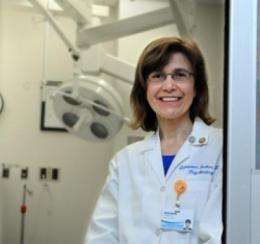Virtual patient may help future doctors prevent suicide

A virtual patient named Denise may help future physicians feel more comfortable and capable assessing suicide risk.
"Primary care doctors tend to be the frontline providers for people with mental illness so we need to put the same kind of educational effort into suicide risk assessment that we put into recognizing a heart attack," said Dr. Adriana Foster, psychiatrist at the Medical College of Georgia at Georgia Health Sciences University and principal investigator on an American Foundation for Suicide Prevention-funded study to determine how to do just that.
"Suicide risk assessment should be one of the 'must haves," said Foster, who hopes Denise, a mother and wife seeking psychiatric care for insomnia and a mood disorder, can help.
Suicide is occurring earlier and more often in the United States than ever before. Rates are up 25 percent in the last decade to 12.4 per 100,000 individuals annually. It's the second-leading cause of death for college students and third for all 15-24 year olds, according to the American Foundation for Suicide Prevention. Twenty percent of high school students report having seriously considered suicide during the previous 12 months.
The new MCG study of second-year medical students is helping determine if the opportunity to ask tough questions about suicide risk to a virtual (computer-simulated) patient can help real families avoid this tragedy. Forty sophomore medical students watch a video of a physician interviewing a patient with a mood disorder. The interview includes a suicide risk assessment. Another 40 students will electronically interview Denise, who was designed by the University of Florida Department of Computer and Information Science and Engineering.
Later, all the students go to MCG's Clinical Skills Center to interview an actor portraying a patient with a mood disorder. A subgroup will also interact with a second actor with a different mental health problem. These actors, called standardized patients, are trained to portray and report symptoms associated with a certain condition. Before all MCG students enter their clinically intensive third and fourth years of medical school, they spend time with these patients, honing communication and patient-examination skills.
"We hope this approach will help future practitioners deal with really difficult issues such as suicide, psychosis, anxiety and depression," Foster said. Mood disorders, such as depression, are the most common mental health disorders coming to physician attention that carry a high risk of disability and suicide, she said.
The researchers hypothesize that students who interact with Denise will be better able to assess suicide risk in the standardized patients. If they are right, researchers want to share Denise with other medical students through the Association of American Medical Colleges MedEdPORTAL (see https://www.mededportal.org/), an online medical education tool collection. They also want to study Denise's long-term impact on students as they take clinical rotations in psychiatry and graduate from medical school.
While students type their questions and mostly get a typed response from Denise, the virtual interaction helps them think through what to ask and the best way to ask it. In fact, Denise tells them when she doesn't understand. To enhance Denise's inter-actability, MCG is sharing unanswered questions with collaborators at the University of Florida, to see if maybe she should respond. As in life, sometimes the problem is just a matter of phrasing.
Studies show that front-line providers, such as family medicine physicians, don't feel comfortable assessing suicide risk. In countries with some of the highest suicide rate, such as Japan and Hungary, targeted provider education has helped decrease rates.
MCG already uses a virtual patient with depression in the first-year curriculum to help students learn the basics of asking about a depressed mood. First- and second-year students also get several lectures and team-based learning sessions focused on mental health, Foster said. "While there has been tremendous progress in the last few years introducing mental health topics to first- and second-year students, they tend to remain somewhat textbook- and other reading material-bound. We are trying to introduce more interactive methods."
Warning signs of suicide include unrelenting low mood, hopelessness, desperation, anxiety, withdrawal, sleep problems, increased alcohol and/or other drug use, impulsiveness, taking unnecessary risks and threatening suicide or expressing a strong wish to die, according to the American Foundation for Suicide Prevention.
"Most suicides don't occur out of the blue," Foster said, and most suicidal individuals are open to intervention. "Most people are actually ambivalent about it and seeking help," making provider assessment and family/friend awareness even more important, she said. "There is a lot of stigma, a lot of things friends and family feel they should never talk about. But when you are a doctor, a lot of your patients are going to have these types of disorders in addition to physical disorders. We want our students to be prepared and not afraid to ask questions."

















